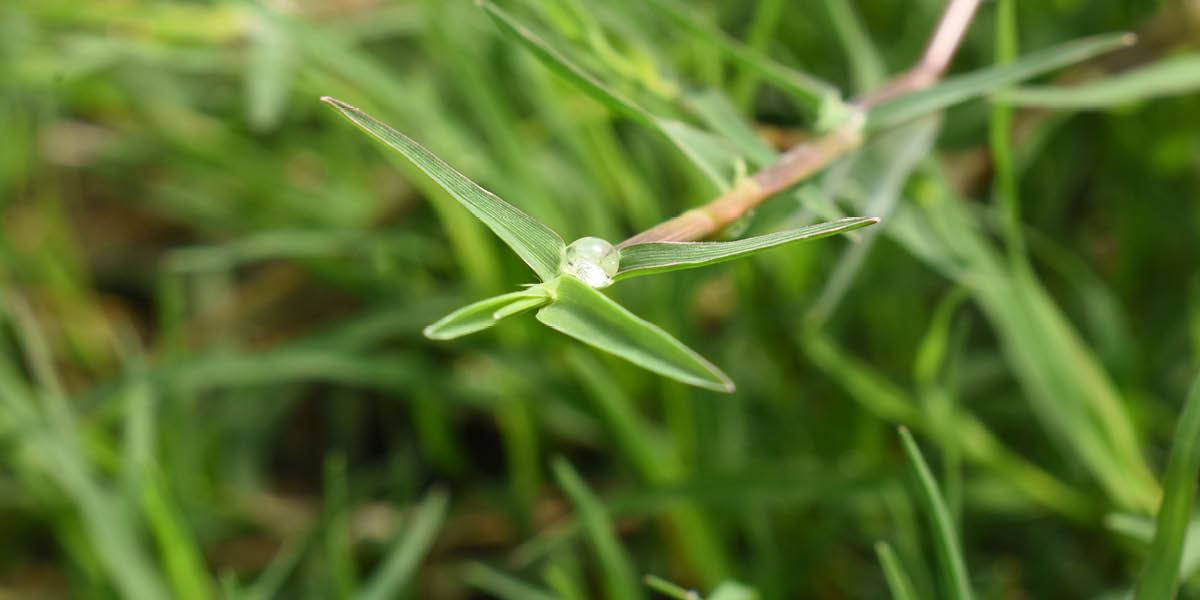It takes years of research and product development to produce a new turf grass, with researchers constantly testing new varieties to make sure they’re superior to existing material and are ready to meet consumer expectations in the market. TurfBreed’s senior research scientist for TurfRND Dr Andrew Fletcher explains how when TurfBreed hand-picks one of these new varieties for trialling in Australia, our growers can be sure they’ll be producing the best product that attracts a premium price.
Introducing IronCutter– the latest in elite Hybrid Bermudagrass genetics, selected and bred by acclaimed turf and forage grass breeder Dr Charles Taliaferro (from the Italian name Tagliaferro, literally translated as “IronCutter”).
Dr Taliaferro has an esteemed career breeding successful turfgrasses for a variety of conditions in the United States (US). His rigorous testing at the US National Turfgrass Evaluation Program (NTEP) shows his latest innovation, IronCutter, is no exception.
TurfBreed is proud to announce that in partnership with Mountain View Seeds, IronCutters’ exclusive marketing partner in the US, this variety has successfully been imported onto Australian shores.
Ironcutter is currently undergoing testing and evaluation in a range of Australian growing conditions to ensure it is suitable for the diverse Australian market.
TurfBreed, through our research and development division TurfRND, is excited to see how this variety performs in Australia after already exceeding expectations overseas.
Already, several of our growers are lucky enough to have their hands on some samples for field evaluations.
IronCutter elite Hybrid Bermudagrass represents the latest advancements in turf genetics.
While at face-value people might consider it “just another Couch”, its status and pedigree as an “elite hybrid Bermudagrass” distinguishes it as a higher value product compared to regular Couches. Therefore, TurfBreed expects our IronCutter growers to achieve a premium price for a premium product.

Behind Ironcutter
IronCutter was born and bred in Enid, Oklahoma and selected specifically to be highly adapted to the harsh winters while, as well, still being a top performer in warmer climates.
NTEP trialling has showed that in the extreme winters of Maryland, which experiences 64.5 days per year with minimum temperatures below 0°C on average, IronCutter was the highest rated turfgrass by overall quality. This was as well as it maintaining top ratings in the more temperate and subtropical climates of Florida, Georgia and Texas (see Table 1).

Table 1. Turf Quality by State.
Averaged across all 17 NTEP trial sites, IronCutter scored excellent year-round levels of groundcover, with above average groundcover ratings in all seasons recorded (see Figure 1 below).

Figure 1 – Average groundcover in all seasons recorded (2014-2017).
When it came to bearing the brunt of brutal winter conditions, IronCutter had some of the lowest rates of winterkill (frost damage; see Figure 2). Meaning Ironcutter would not only survive and recover after cold winters and frosty mornings, but also hold its colour and health longer.
Not only does IronCutter tolerate extreme winters better than any other variety, but it also recovers faster and stronger too. It consistently performed better than the trial average for spring greenup ratings, showing that it recovers from winter dormancy and frosts faster than other varieties (see Figure 1 above).
In the extreme cold conditions of the Maryland spring greenup trial site, IronCutter significantly outperformed TifTuf Hybrid Bermudagrass in recovering from winter with an exceptional rating of 6.3 compared to TifTuf with a below average of 4. Ironcutter is truly the most adapted elite Hybrid Bermudagrass for cooler climates!
IronCutter also has demonstrated its ability to thrive in both hot and humid climates as well as extreme summers and winters.
Forged in Oklahoma, IronCutter is therefore set to show its strength right here in Australia.

Figure 2 – IronCutter shows its strength in the coldest of climates.
(Winterkill results showing the percentage of turfgrass killed at each location for all 35 varieties which were part of the study, including IronCutter and TifTuf, and which were averaged over three winters. LSD: IN = 20.2, KY = 32.)

Figure 3 – Spring greenup ratings.
(LSD: Avg. = 0.7, FL = 1.4, GA = 1.4, MD = 1.2, TX = 1.4.)
When it comes to wear and tear, IronCutter is ready to handle anything you throw at it.
In two independent studies, IronCutter showed its strength yet again by demonstrating its ability to tolerate more wear than other varieties (see Figure 4 below), but also to recover faster after tolerating much higher wear when trialled under real world conditions as a football field sports turf in Knoxville, Tennessee.

Figure 4 – Traffic study at Knoxville, Tenessee (2016).
(Winterkill results showing the percentage of turfgrass killed at each location for all 35 varieties which were part of the study, including IronCutter and TifTuf, and which were averaged over three winters. LSD: IN = 20.2, KY = 32.)

Figure 5 – Turf recovery after divot damage at Fayetteville, Arkansas (2016).
Disease and pest resistance is another area of concern for a lot of turf growers, especially those in humid areas prone to fungal disease and soil borne pests.
In the US NTEP disease and pest trials, once again IronCutter received exceptional scores all round, with excellent resistance to mites and fungal diseases, and very high resistance to mites and spring dead spot (see Table 2 below).

Table 2. Ratings for resistance to turf disease and stunt mites showing trial averages and the performance of IronCutter.
(1Data averaged from Florida, Gainsville and North Carolina sites, 2data averaged from Arkansas and Maryland sites, 3data collected from the Arizona site.)
In the tropical conditions of Gainesville in Florida, nematode trials were conducted to evaluate resistance to 10 types of harmful nematodes between 2013 and 2017. In this study, IronCutter pulled ahead yet again by displaying a 14 per cent overall reduction in nematode counts compared to the trial average (see Figure 6 below).
Bred as an elite Hybrid Bermudagrass, IronCutter is an interspecific hybrid cross of Cynodon dactylon var. dactylon (L.) Pers. and Cynodon transvaalensis Burtt-Davy.
Not only has Ironcutter been bred to be highly sterile and produce very little pollen or seed, it also shows excellent ratings for seedhead in NTEP testing, making it more applicable in settings where seedhead and flowering are problematic.

Figure 6 – IronCutter had 14 per cent fewer nematodes compared to the trial average.
(Average data for Gainesville, Florida from 2013 – 2017).

Figure 7 – Seedhead Ratings from NTEP testing.

